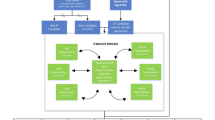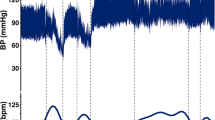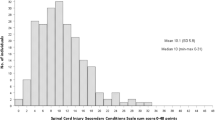Abstract
Study design:
Multi-center cross-sectional cohort study.
Objectives:
The objectives of this study were to develop and validate short forms (SFs) of participation for child- and parent-reported outcomes following spinal cord injury (SCI).
Setting:
Three pediatric orthopedic hospitals in the United States.
Methods:
The expert panel used calibration data from the pediatric computerized adaptive test (CAT) development study (convenience sample of 381 children and adolescents with SCI and 322 parents or caregivers) to select SF items. The panel selected items for two domains (participation self—relevant to what I want to do; participation friends—relevant to what my friends do), with parent and child versions for each domain. Psychometric analyses included group reliability, Cronbach’s alpha, agreement (SFs and item banks), percent of sample with highest (ceiling) and lowest (floor) scores by level of lesion (paraplegia/tetraplegia), and test information function.
Results:
Group reliability and Cronbach’s alpha values are acceptable (0.74–0.92) and agreement (intraclass correlation coefficients for SFs and total item banks) is strong (0.89–0.95). Floor effects were minimal for people with tetraplegia and paraplegia (0–1.19%). Ceiling effects were minimal for people with tetraplegia (0–3.13%) and slightly higher, but acceptable, for people with paraplegia (8.06–14.02%). Test information function for the SFs was sufficiently high over the range of scores for the majority of the sample.
Conclusion:
Pediatric Measure of Participation (PMoP) SFs are acceptable for use when CATs are not feasible.
Sponsorship:
The study was funded by the Shriners Hospitals for Children Research Grant 79142 (Mulcahey, PI) and the Boston ROC Grant 5R24HD065688-05 (Jette, PI).
Similar content being viewed by others
Log in or create a free account to read this content
Gain free access to this article, as well as selected content from this journal and more on nature.com
or
References
Chi-Wen C, Rodge S, Copley J, Skorka K . Comparative content review of children’s participation measures using the international classification of functioning, disability and health – children and youth. Arch Phys Med Rehab 2014; 95: 141–152.
World Health Organization (WHO). International classification of functioning disability and health version for children and youth. 2004. WHO: Geneva.
Young NL, Williams JI, Yoshida KK, Wright JG . Measurement properties of the activities scale for kids. J Clin Epidemiol 2000; 53: 125–137.
Mandich AD, Polataijko HJ, Miller LT, Baum C . Paediatric Activity Card Sort (PACS). CAOT Publications ACE: Ottawa, Canada. 2004.
Rosenblum S, Sachs D, Schreuer N . Reliability and validity of the children’s leisure assessment scale. Am J Occup Ther 2010; 64: 633–641.
King GA, Law M, King S, Hurley P, Hanna A, Kertoy M et al. Measuring children’s participation in recreation and leisure activities: construct validation of the CAPE and PAC. Child Care Health Dev 2007; 33: 28–39.
Rosenberg L, Jarus T, Bart O . Development and initial validation of the children’s participation questionnaire (CPQ). Disabil Rehabil 2010; 32: 1633–1644.
Bedell G . Further validation of the child and adolescent scale of participation (CASP). Dev Neurorehabil 2009; 12: 342–351.
Bourke-Taylor H, Law M, Howie L, Pallant J . Development of the assistance to participate scale (APS) for children’s play and leisure activities. Child Care Health Dev 2009; 35: 738–745.
Fougeyrollas P, Noreau L, Bergeron H, Cloutier R, Dion SA, St-Michel G . Social consequences of long term impairments and disabilities: conceptual approach and assessment of handicap. Int J Rehabil Res 1998; 21: 127–141.
Dunn L, Magalhaes LC, Mancini MC . Internal structure of the Children Helping Out: Responsibilities, Expectations, and Supports (CHORES) measure. Am J Occup Ther 2014; 68: 286–295.
Klaas S, Kelly EH, Gorzkowski J, Homko E, Vogel LC . Assessing patterns of participation and enjoyment in children with spinal cord injury. Dev Med Child Neurol 2010; 52: 468–474.
Mulcahey M, Calhoun C, Riley A, Haley S . Children's reports of activity and participation after sustaining spinal cord injury: a cognitive interviewing study. Dev Neurorehabil 2009; 12: 191–200.
Mulcahey M, Calhoun C, Tian F, Ni P, Vogel L, Haley S . Evaluation of newly developed item banks for child-reported outcomes of participation following spinal cord injury. Spinal Cord 2012; 50: 915–919.
Tian F, Ni P, Mulcahey M, Hambleton R, Tulsky D, Haley S et al. Tracking functional status across the spinal cord injury lifespan: linking pediatric and adult patient-reported outcome scores. Arch Phys Med Rehabil 2014; 95: 2078–2085.
McConachie H, Colver AF, Forsyth RJ, Jarvis SN, Parkinson KN . Participation of disabled children: how should it be characterized and measured. Disabil Rehabil 2006; 28: 1157–1164.
Heinemann A, Dijkers M, Ni P, Tulsky D, Jette A . Measurement properties of the Spinal Cord Injury-Functional Index (SCI-FI) short forms. Arch Phys Med Rehabil 2014; 95: 1289–1297.
Bagwell CL, Schmidt ME . Importance of Friends and Friendships in Childhood and Adolescence. Guilford Press: New York, USA. 2011.
Buhrmester D . Intimacy of freindship, interpersonal competence and adjustment during preadolscense and adolscence. Child Dev 1990; 61: 1101–1111.
Slavin M, Mulcahey MJ, Vogel LC, Calhoun Thielen C, Jette AM . Development and validation of short forms of activity for youth with SCI. Spinal Cord 2016; 54: 546–552.
Acknowledgements
The study was funded by the Shriners Hospitals for Children Research Grant 79142 (Mulcahey, PI) and the Boston ROC Grant 5R24HD065688-04 (Jette, PI).
Author information
Authors and Affiliations
Corresponding author
Ethics declarations
Competing interests
The authors declare no conflict of interest.
Additional information
Supplementary Information accompanies this paper on the Spinal Cord website
Supplementary information
Rights and permissions
About this article
Cite this article
Mulcahey, M., Slavin, M., Ni, P. et al. The Pediatric Measure of Participation (PMoP) short forms. Spinal Cord 54, 1183–1187 (2016). https://doi.org/10.1038/sc.2016.68
Received:
Revised:
Accepted:
Published:
Issue date:
DOI: https://doi.org/10.1038/sc.2016.68
This article is cited by
-
Pediatric measure of participation short forms version 2.0: development and evaluation
Spinal Cord (2021)
-
The International Spinal Cord Injury Pediatric Activity and Participation Basic Data Set
Spinal Cord Series and Cases (2019)
-
Development of the International Spinal Cord Injury/Dysfunction Education Basic Data Set
Spinal Cord Series and Cases (2019)
-
Recommendations for the National Institute for Neurologic Disorders and Stroke spinal cord injury common data elements for children and youth with SCI
Spinal Cord (2017)



